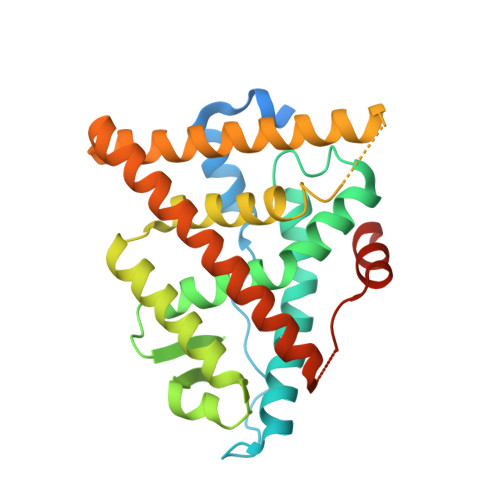Unexpected equivalent potency of a constrained chromene enantiomeric pair rationalized by co-crystal structures in complex with estrogen receptor alpha.
Zhang, B., Kiefer, J.R., Blake, R.A., Chang, J.H., Hartman, S., Ingalla, E.R., Kleinheinz, T., Mody, V., Nannini, M., Ortwine, D.F., Ran, Y., Sambrone, A., Sampath, D., Vinogradova, M., Zhong, Y., Nwachukwu, J.C., Nettles, K.W., Lai, T., Liao, J., Zheng, X., Chen, H., Wang, X., Liang, J.(2019) Bioorg Med Chem Lett 29: 905-911
- PubMed: 30732944
- DOI: https://doi.org/10.1016/j.bmcl.2019.01.036
- Primary Citation of Related Structures:
6DF6, 6DFN - PubMed Abstract:
Despite tremendous progress made in the understanding of the ER¦Á signaling pathway and the approval of many therapeutic agents, ER+?breast cancer continues to be a leading cause of cancer death in women. We set out to discover compounds with a dual mechanism of action in which they not only compete with estradiol for binding with ER¦Á, but also can induce the degradation of the ER¦Á protein itself. We were attracted to the constrained chromenes containing a tetracyclic benzopyranobenzoxepine scaffold, which were reported as potent selective estrogen receptor modulators (SERMs). Incorporation of a fluoromethyl azetidine side chain yielded highly potent and efficacious selective estrogen receptor degraders (SERDs), such as 16aa and surprisingly, also its enantiomeric pair 16ab. Co-crystal structures of the enantiomeric pair 16aa and 16ab in complex with ER¦Á revealed default (mimics the A-D rings of endogenous ligand estradiol) and core-flipped binding modes, rationalizing the equivalent potency observed for these enantiomers in the ER¦Á degradation and MCF-7 anti-proliferation assays.
Organizational Affiliation:
Genentech Inc., 1 DNA Way, South San Francisco, CA 94080, USA. Electronic address: zhang.birong@gene.com.


















